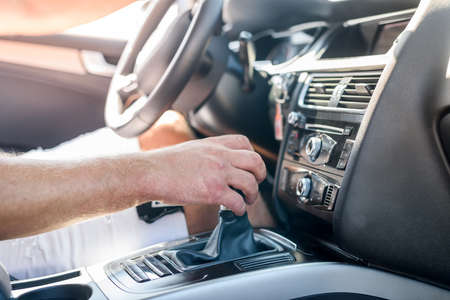1. The Evolution of In-Car Entertainment
In-car entertainment has come a long way over the years, especially in the United States where road trips and daily commutes are a big part of life. Let’s take a quick trip down memory lane to see how things have changed from old-school radios to today’s high-tech streaming platforms.
From AM Radios to Streaming Services
Back in the day, AM radios were the standard for car entertainment. People tuned in to catch their favorite music or local news while driving. As technology improved, FM radio offered better sound quality and more channels. Soon after, cassette players and CD players made it possible for drivers to bring their own music along for the ride.
Milestones in Car Entertainment
| Era | Main Technology | Popular Use |
|---|---|---|
| 1950s-1960s | AM Radio | News & Music Broadcasts |
| 1970s-1980s | FM Radio, 8-Track & Cassette Players | Music Customization Begins |
| 1990s-2000s | CD Players, Satellite Radio | Crisper Sound, More Choices |
| 2010s-Present | Bluetooh, Streaming Services, Smart Displays | On-Demand Music & Video |
The Streaming Revolution Hits the Road
Todays cars are more than just a way to get from point A to point B. With built-in WiFi, advanced touchscreens, and smartphone integration like Apple CarPlay and Android Auto, drivers and passengers can now access apps like Spotify, Apple Music, YouTube, and Netflix right from their dashboard.
The American Lifestyle Connection
This shift in car entertainment reflects bigger trends in American lifestyles. Americans love convenience and personalization—streaming services let you listen to your favorite playlists or watch shows on long trips without missing a beat. Whether you’re commuting to work or heading out on a weekend adventure, your car can now double as your own private media hub.
2. Music on the Go: Integration of Streaming Services
Bringing Your Favorite Tunes to the Road
In recent years, streaming services like Spotify, Apple Music, and Pandora have become an essential part of how Americans enjoy music every day. Now, these popular platforms are making their way directly into our cars, changing how we experience music while driving. No more fiddling with CDs or searching for radio stations—drivers can simply connect their favorite apps and hit play.
How Streaming Apps Connect to Your Car
Most new vehicles come equipped with infotainment systems that support Apple CarPlay and Android Auto. This means drivers can use voice commands or touchscreen controls to access their personal playlists, discover new songs, or listen to podcasts without taking their eyes off the road.
| Streaming Service | Main Features in Cars | Compatible Systems |
|---|---|---|
| Spotify | Personalized playlists, curated road trip mixes, offline mode | Apple CarPlay, Android Auto |
| Apple Music | Siri voice commands, extensive library, seamless iPhone integration | Apple CarPlay |
| Pandora | Custom radio stations, on-demand listening, thumbs up/down feature | Apple CarPlay, Android Auto |
The Impact on Drivers’ Preferences
This easy access to streaming services has changed what people listen to on the road. Instead of being limited to local radio or a few CDs, drivers can now set the mood for any trip—whether it’s a morning commute or a cross-country adventure. Playlists for different moods or occasions (like “Summer Drive” or “Family Road Trip”) have become hugely popular.
A New Road Trip Culture
The rise of in-car entertainment is also shaping American road trip culture. Families and friends can share playlists and discover new artists together as they travel. Some even create collaborative playlists before a big journey so everyone gets a say in the soundtrack. With streaming services so easily integrated into vehicles, music is truly becoming a shared part of every drive.
![]()
3. Video Streaming and Rear-Seat Entertainment
When it comes to keeping everyone happy on the road, video streaming has become a real game changer for in-car entertainment, especially for families and those taking long trips. Gone are the days when rear-seat passengers had to rely on DVDs or hope someone brought enough movies. Now, with platforms like Netflix and YouTube built right into modern vehicles, passengers can watch their favorite shows and videos from anywhere.
Why Video Streaming is Popular in Cars
Streaming services make it easy for kids and adults alike to access hours of content without needing extra devices or physical media. This is a big deal during family road trips—while parents focus on driving, kids can enjoy cartoons, movies, or educational programs in the back seat. These platforms even offer options for offline viewing if youre heading somewhere with spotty Wi-Fi or cell service.
Key Benefits for Rear-Seat Passengers
| Benefit | Description |
|---|---|
| Entertainment Variety | Access to thousands of shows, movies, and YouTube channels keeps all age groups entertained. |
| No More “Are We There Yet?” | Engaging content helps pass the time and reduces complaints during long drives. |
| Parental Controls | Parents can set restrictions to ensure kids only watch age-appropriate content. |
| Personalized Profiles | Each family member can have their own profile with tailored recommendations. |
| Seamless Integration | Many new cars now feature integrated screens and apps for a smooth experience without needing tablets or smartphones. |
How Automakers Are Adapting
Automakers know how important rear-seat entertainment has become. Brands like Tesla, Ford, and Chrysler now offer built-in screens that support popular streaming apps directly through the cars infotainment system. Some SUVs and minivans come with dual screens so siblings dont have to fight over what to watch. With Wi-Fi hotspots available in many models, streaming high-quality video is easier than ever—even on the move.
4. Staying Connected: Connectivity Features and Data Plans
Built-In Wi-Fi and Bluetooth: The Backbone of In-Car Streaming
Modern cars are no longer just a way to get from point A to point B—they’re now rolling entertainment hubs. Thanks to built-in Wi-Fi hotspots and Bluetooth connectivity, your car can easily connect to streaming services for music, podcasts, audiobooks, and even video content (for passengers). These features allow you to sync your favorite devices or stream directly through the car’s infotainment system without fumbling with cables or worrying about losing signal on the road.
How Connectivity Powers In-Car Entertainment
| Feature | Function | Benefit for Drivers & Passengers |
|---|---|---|
| Built-in Wi-Fi Hotspot | Connects multiple devices to the internet using the car’s cellular data plan | Enables streaming for everyone in the vehicle; reduces mobile data usage on personal devices |
| Bluetooth Connectivity | Pairs smartphones and tablets with the car’s audio system | Allows hands-free control and seamless audio streaming from personal playlists or apps |
| Integrated Apps | Apps like Spotify, Apple Music, or Netflix pre-installed in the car’s infotainment unit | No need for external devices; direct access to favorite media through touchscreen controls |
The Role of Affordable Data Plans
Automakers now offer a range of affordable data plans through partnerships with major U.S. carriers. This means you can subscribe to monthly or yearly plans that provide enough bandwidth for all your streaming needs—without breaking the bank. Whether you’re on a family road trip or your daily commute, having reliable internet access in your vehicle is becoming an expectation rather than a luxury.
What This Means for Consumers’ Expectations
With these connectivity features becoming standard in many new vehicles, American drivers now expect their cars to deliver the same seamless digital experience they get at home. People want uninterrupted music playlists, kids want access to movies during long drives, and everyone appreciates real-time traffic updates or live sports streams. The line between home entertainment and in-car entertainment is quickly fading, pushing automakers to keep innovating in this space.
5. Safety, Distraction, and the Future of In-Car Streaming
Keeping Safety First: The Challenge of In-Car Streaming
As streaming services become more popular in cars across the U.S., safety is top of mind for drivers and regulators. While it’s exciting to have access to music, podcasts, and even video content while on the road, there are real concerns about driver distraction. Watching videos or navigating complex menus can easily take your focus off the road, leading to potential accidents. That’s why automakers and tech companies are working hard to make in-car streaming as safe as possible.
How Automakers Are Addressing Distraction
Many car brands now limit video playback to when the vehicle is parked, so drivers cant watch Netflix or YouTube while driving. Audio streaming (like Spotify or Apple Music) is usually available at all times, but with features like large, easy-to-read buttons and simplified menus to minimize distraction. Here’s a quick look at how common streaming activities are managed for safety:
| Streaming Activity | When Its Allowed | Safety Features |
|---|---|---|
| Music/Podcasts | Anytime (Driving/Parked) | Voice commands, steering wheel controls |
| Video Streaming | Only When Parked | Screen disables during driving |
| Navigation Apps | Anytime (Driving/Parked) | Audio guidance, minimal interaction needed |
The Rise of Voice Control and Touch-Free Interfaces
One major trend in American vehicles is the shift toward voice control and touch-free technology. Systems like Apple CarPlay, Android Auto, Amazon Alexa Auto, and built-in manufacturer solutions let drivers play their favorite playlists, start a podcast, or get directions—all by just speaking. This hands-free approach helps keep eyes on the road and hands on the wheel.
Popular Voice Control Features in U.S. Cars:
- “Hey Siri/Google/Alexa, play my Road Trip playlist.”
- “Call Mom.”
- “Navigate to Starbucks.”
- “Skip this song.”
- “What’s the weather like?”
The Future: What’s Next for In-Car Entertainment?
The future of in-car streaming in America is bright—and getting smarter every year. We’re seeing innovations like gesture control (wave your hand to change songs), personalized recommendations that adapt to your mood or route, and even augmented reality displays on windshields showing navigation or entertainment info without taking your eyes off the road. Some experts believe we’ll soon see fully integrated entertainment hubs that connect seamlessly with home devices and personal accounts.
Key Innovations on the Horizon:
- More advanced voice assistants with natural conversation abilities.
- Bigger and better touchscreens that only work when parked.
- Personalized content recommendations based on who’s in the car.
- Integration with smart home devices—control your lights or thermostat from your car!
- Built-in parental controls for families on the go.
The evolution of in-car streaming services is making American road trips more entertaining than ever—but always with a focus on keeping everyone safe behind the wheel.


